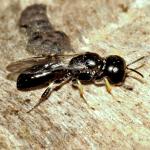Some authors (e.g. Lomholdt, 1984; Dollfuss, 1991) cite the authority of this species as Dahlbom (1845), although more recent works (e.g. Bitsch & Leclercq, 1993, and the current Pan-European Species Directories Infrastructure) accept the earlier publication date.
This species was discovered as new to Britain in 1999. It is assumed to be a recent colonist.
Thus far, British records are restricted to the home counties fringing London. It was first recorded by R. Uffen at a site in Rickmansworth, Hertfordshire (Early & Uffen, 2008). Subsequent records cited by Early & Uffen are: Mill Hill, Middlesex and Colney Heath, Hatfield, Hertfordshire, both in 2004; Rye House, Hoddesdon, Hertfordshire in 2005 and Reigate Heath, Surrey in 2008. An apparent eastern range extension was then noted, with Knowles (2009; 2010) giving records for Loughton and Harlow, respectively, both in South Essex. Further records have come from Essex and Surrey.
Abroad it is found sparingly across central and northern Europe, eastwards through Kazakhstan to Siberia. Citations of the species occurring in Japan may refer to a distinct Japanese species which was, until 1973, named C. congener (Bitsch & Leclercq, 1993).
As a recent colonist, this species has yet to be treated by a published status review. Based on the few records so far, it is perhaps too early to tell if this species will establish permanent populations in the British Isles.
Potentially found in a wide variety of habitats, where suitable nesting substrates occur. British records come from scrubby heaths and commons, hedgerows in floodplain grassland and open broad-leaved woodland.
The very limited British data covers June through to September, which accords with continental observations in Dollfuss (1991).
Information from Tsuneki (1960) cited in earlier works (e.g. Lomholdt, 1984) appears to refer to a separate Japanese species, formerly known as C. congener. Prey items remain currently unknown, although they are likely to be small flies.
Bitsch & Leclercq (1993) cite observations on flowers of umbellifers (Apiaceae).
No data available.
2018


